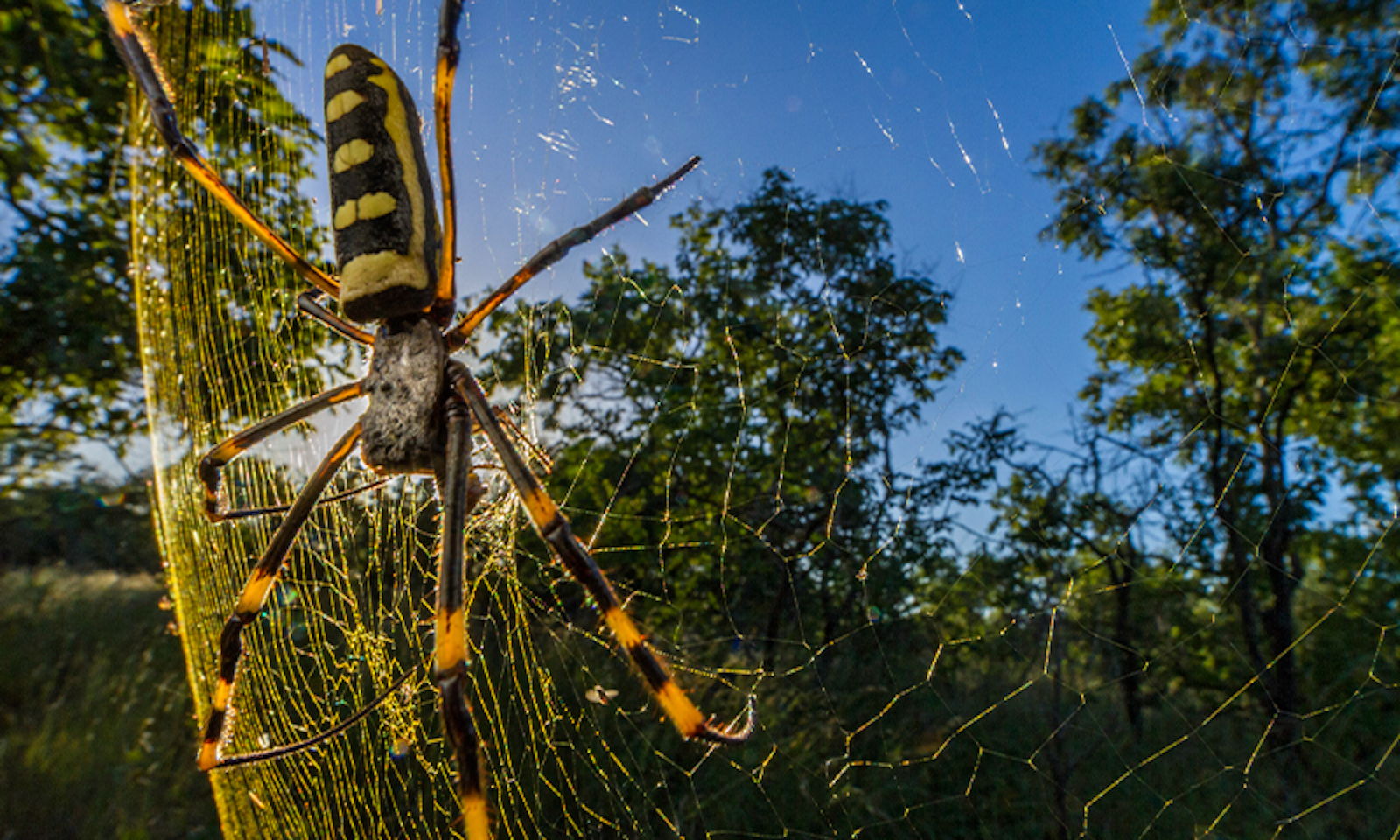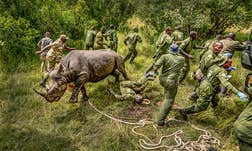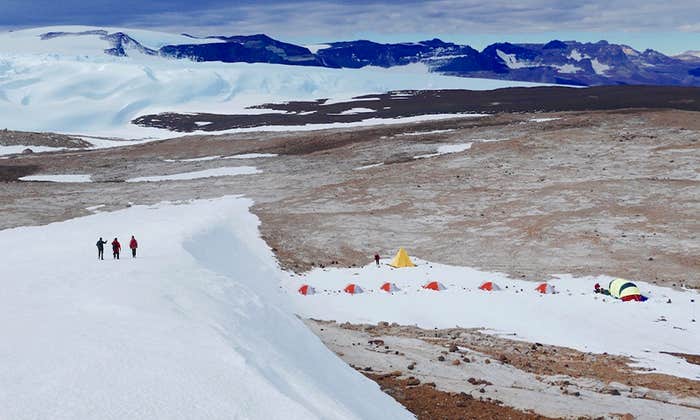
There’s a psychological phenomenon called pareidolia that Piotr Naskrecki, an entomologist from Harvard University, often thinks about on slow walks around Gorongosa National Park in Mozambique. Pareidolia describes an experience when people see a meaningful image in a random visual pattern: faces in a piece of toast, human figures in trees. It has to do with our evolution. In our prehistoric years, humans needed to be prepared for anything hiding in the bushes. Even if a poisonous snake turned out to have been a stick, it was a good idea to have jumped over it. At Gorongosa, Naskrecki harnesses this basic human impulse for science. “I let my mind take the reins of my imagination and guide me toward finding things that I normally would have completely missed,” he says.
Naskrecki finds many biological questions can be best answered with a slow walk. Even as an experienced naturalist, he finds the world opens up when he moves slowly and starts to notice things: a dried-up leaf on the side of the path may be hiding a caterpillar on the underside. Or it may not be a leaf at all, it might be a moth. Or a leaf-mimicking insect. Scientific findings are everywhere in the park, underfoot and overhead. Gorongosa is a living laboratory in the wild.
There are 10,000 species of spiders alone. What role do they play?
When Naskrecki first visited Gorongosa in 2012, he was completely blown away by the diversity of life. He saw an untold abundance of species interacting on all levels, from millipedes crawling in leaf litter to bugs embedded in the fur of bats. He had worked in other parts of Africa, so he thought he’d be prepared for Gorongosa, but what he found at the park left him in awe and wonder. The international scientific community knew so little about this part of the world that 90 percent of what he was seeing was new to science, he says. “It was just this feeling that I was entering a completely blank spot on the map of global biodiversity, and everything that we can contribute will be beneficial and useful toward understanding the biogeography of life.”
Today, Naskrecki is a project leader of the Gorongosa Map of Life project. Its purpose is to document all life in the park, from soil bacteria to elephants and everything in between. Naskrecki and a group of scientists and students from a variety of fields, methodically document a section of the park, recording specimens that might be new to science. Recently, their research took them to a remote area of a limestone plateau dotted with caves. They swept nets to capture insects, turned over rocks and logs to look for reptiles, and used ultrasonic recorders to eavesdrop on bats.
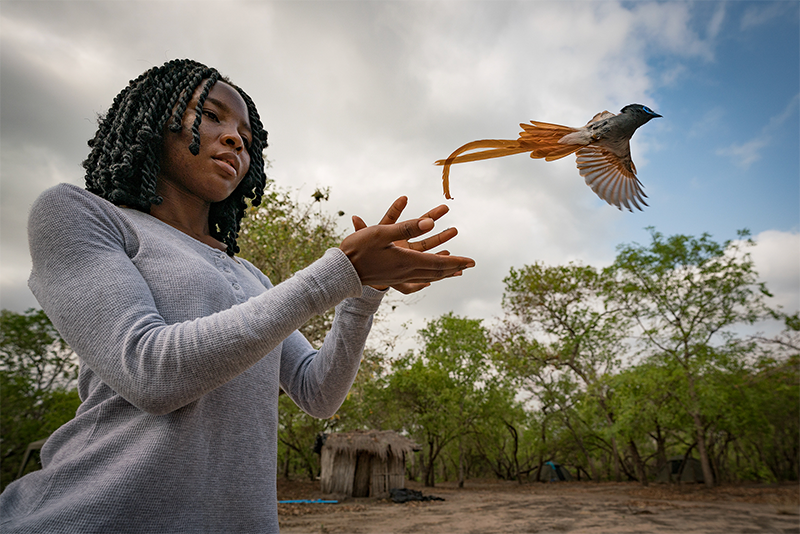
The Gorongosa Map of Life was launched in 2014. Every rainy season, between March and April, the scientists and students sample everything they can, building a multi-dimensional map of interactions. Scientists must know which species make up the park—and how they are related—to conserve them. “Understanding the ecosystem and all its elements is a prerequisite to effective conservation that’s firmly based in science,” Naskrecki says.
Each group of experts conducts field research for nearly a month at a time, moving every week or so to study a new area. They collect fauna in the soil and leaf litter, trap insects, record the songs and sounds of bats, birds, amphibians, and insects, and observe the movement and activity patterns of elephants. They also study external processes such as fire to better understand their value in rejuvenating the landscape and in maintaining biodiversity. The Gorongosa Map of Life is the first inventory of its kind in any protected area in Africa.
So far, the project has documented more than 7,700 species, but scientists predict that there are at least 75,000 multicellular organisms in the park, probably more. “Every time we go on a survey,” says Naskrecki, “we usually add about 1,000 species to that list.” His teams have found a previously undescribed rare spiny crustacean that hasn’t yet been named, and a horseshoe bat—at only 5 grams, the smallest in Africa—among other creatures. They have also recorded heretofore undocumented interactions among species, including an earwig that lives on giant pouched rats, crustaceans that thrive inside fungal gardens of termites, and parasitic bugs that nest in the fur of bats.
Traditionally, scientists have studied connections between any two given species. What sets the Gorongosa Map of Life apart is that participating scientists can investigate multi-trophic interactions that involve several levels of life, from plants to herbivores to predators, parasitoids, or pathogens. “The bigger this database becomes, the more data we have, the more powerful it is and the more complex questions you can ask,” Naskrecki says.
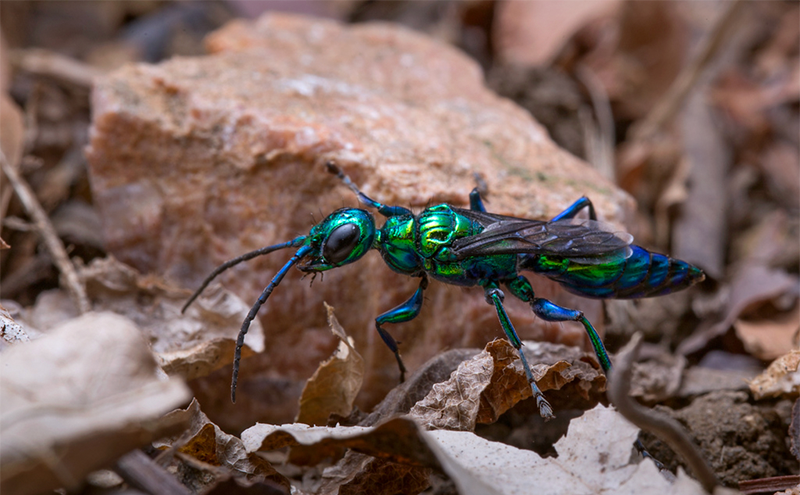
Understanding natural biodiversity can shed light on what needs to be done to restore degraded landscapes, says Marc Stalmans, a landscape ecologist who directs scientific research at the park. He says it’s important to understand how landscapes are destroyed—both to protect what’s left and to rebuild a more livable world, especially in the face of climate change.
In 2019, a massive cyclone led to unusually extensive flooding in Gorongosa, which knocked out termites in many places in the park. After three years, they haven’t been able to recolonize their territory, which has completely changed the dynamics of the woodland savanna where they act as critically important ecosystem engineers. The project’s data will be able to show the long-term impact of cyclones on the ecosystem and species, and, more broadly, demonstrate long-term effects of climate change.
When people talk about the untapped potential of the natural world, Stalmans says, they often use the example of undiscovered pharmaceuticals that could be found in the amazing diversity of plants and animals. But there’s more to nature than chemical compounds. “The potential of biomimicry, for example, is enormous,” Stalmans says. “Nature has evolved form and function that best addresses aspects of energy conservation, protection from the elements, and survival in adverse conditions. We can learn so much from the diversity of life in coping with those challenges.”
The scope of the Gorongosa Map of Life is immense. Scientists would love to trace the connection among soil fauna, canopy fauna, river ecosystems, bacteria, and viruses. Naskrecki estimates there are 10,000 species of spiders in the park. What role do they play in the ecosystem? “There isn’t one specific goal that we want to achieve with the project,” Naskrecki says. “We just want to create a data set that can be endlessly explored and used to make connections between these different elements.”
One project underway at Gorongosa is investigating what is living in the soil. Naskrecki recently worked with a visiting scientist from Poland, who grabbed a scoop of woodland soil and flew it back to his lab, where he put it under a microscope. It was literally alive, bursting with biodiversity. It included more than 50 species of detrivorous soil mites, which feed on decaying organic material, in just that single scoop. Then there was another group of mites that fed on those detrivorous mites—and yet another group feeding on the predators of the mites. The layers of species and their unexplored interactions in the richness of the soil left Naskrecki with a feeling of astonishment. “It shows how nature in general is so fractal that at any given spatial scale you will find similar relationships,” he says.
Only 10 to 20 percent of Earth’s species have been formally described.
Naskrecki is fascinated by parasites, especially the many animals that live off the backs (often literally) or heads of other species. At one point, he was observing a caterpillar who had been parasitized by braconid wasps. The caterpillar’s still-living body was paralyzed, having become the host and food for wasp babies, covered with tiny cocoons, something he found both “super cool and kind of cruel.” He watched a tiny wasp sitting on top of the cocoons. Was it the moment of emergence from the host? As he looked closer, he realized a different type of drama was happening: The wasp was a hyperparasite, laying eggs in the creatures that had just emerged from the caterpillar. It was a quatratrophic interaction: caterpillar eats leaves, parasites eat caterpillar, hyperparasitoids eat the parasites. The relationships between each level are completely unique—each type of caterpillar only eats one type of plant, and so on—and they all rely on one another. Each of these specialized parasites typically represents a new species, and it’s one reason scientists now think parasitic wasps are probably the most species-rich group of organisms on Earth.
Those interactions are part of what makes Gorongosa so fascinating. The park’s habitats range from rainforests to woodland, savannah, and marshes, which makes it one of a handful of parks around the world with so many ecosystems in one protected place. It’s located at the southernmost part of the great African Rift Valley, which rends the continent north to south from the Red Sea to Lake Malawi. This geologic formation channels life from East Africa to the park in a way that makes Gorongosa a converging zone for southern and eastern African species, an ideal nature-made lab to understand how species interact with their environment.
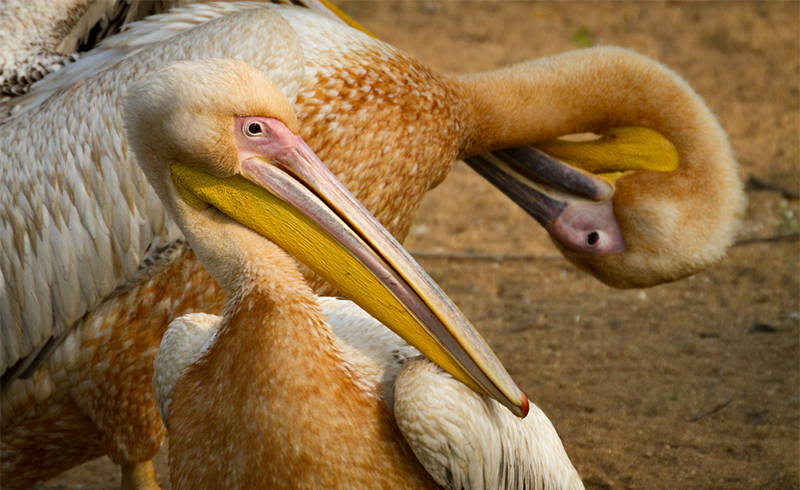
It’s also a location that hasn’t been studied deeply until recently. The park was established in 1960 and became known for its vast numbers of hippos, wildebeest, and zebras unique to Gorongosa. But as the park was beginning to gain interest from scientists, Mozambique was going through turbulent times. It gained sovereignty from Portugal in 1975 after a decade-long war for independence, then spiraled into another civil war three years later. That war lasted 15 years, and Gorongosa was a hotspot of fighting, whiplashing between government and rebel control. When scientists were able to return to the park safely in the 1990s, the landscape was there, but up to 90 percent of the wildlife had disappeared.
It’s impossible, of course, to do effective conservation without knowing what you’re trying to protect, especially when resources are extremely limited. Gorongosa is an enormous space—about 1 million hectares that include, uncommonly for a national park, a peripheral area where people live in settlements and villages—so the park wants to deploy resources in the most targeted way possible. Gorongosa Map of Life focuses on the centers of endemic species because that’s where conservation can make the most impact. One of those hot spots is Mount Gorongosa, elevation 6,112 feet, an isolated mountain that, at 18.4 degrees south of the equator, holds the remnants of one of the southernmost tropical rainforests in Africa. “Having this type of a map, knowing exactly what we have and where, allows us to make wiser and better decisions about how to do conservation,” Naskrecki says.
In 2008, the park entered into a public-private partnership with the Carr Foundation to rewild the area, and has since gone through a renaissance. The park also works with local communities to promote opportunities in an area that has struggled economically. Vitally, the scientists studying Gorongosa also live and work on site. “Particularly in Mozambique, there have been huge gaps in the history of natural research, so there are many things we do not know about yet,” says Bart Wusten, a botanist based in Belgium who has been working with Gorongosa for decades, doing surveys of vegetation. The data he has collected can now help set a baseline for future studies.
So far, the Gorongosa Map of Life has collected approximately 210,000 individual observations across different habitats and across different timelines. The participating scientists discovered over 200 species new to science—from mammals to invertebrates and plants. Other species that exist only in the park include a katydid whose loud nocturnal serenades dominate the mountain soundscape yet are undetectable by humans, and a new species of long-fingered bat. It’s the most extensive scientific biodiversity work in Africa, with samples and data points stored in a lab at the park and also sent across the world to nearly 70 partnering universities.
The map also allows scientists to see deeper into the hidden connections between organisms. They have documented insects that change their behavior in response to bat predation. The scientists have been able to create a library of echolocation calls of bats, and recordings of singing insects and frogs. They are currently putting together a dictionary of verbs, phrases, and words used by bats to convey certain messages. (Nautilus will publish a separate story about this work in the coming months.) “Everybody knows about echolocation,” says Naskrecki, “but bats actually have a very complex social language and we are trying to understand it.”
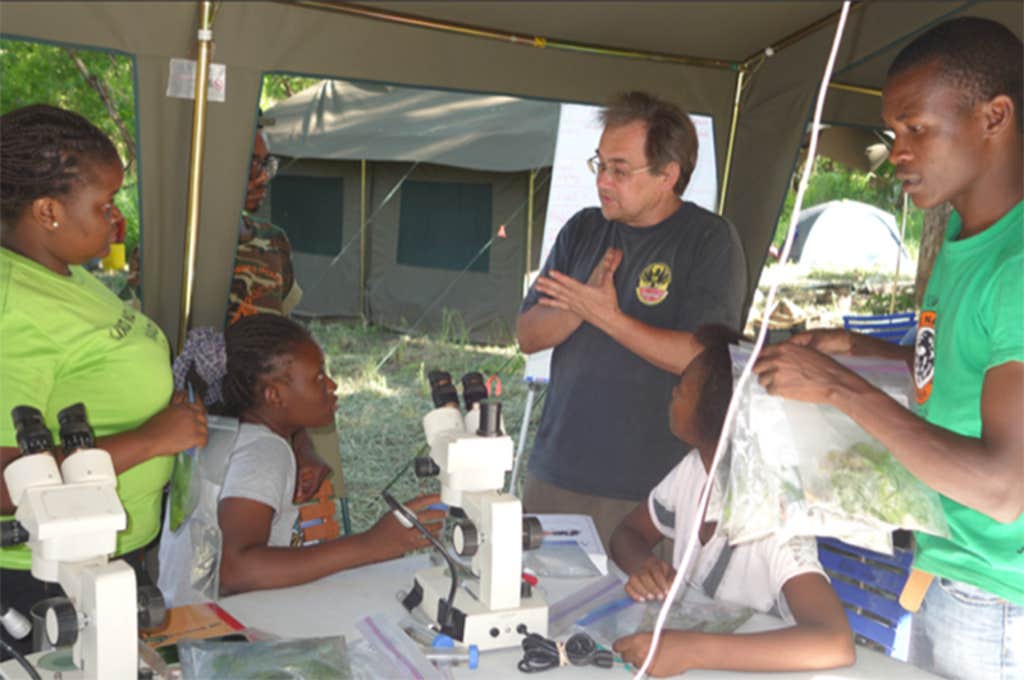
Another place to see interactions among species is in carcasses. On an impala antelope, there might be 250,000 fly larvae, and those flies are being preyed upon by hister beetles. The contents of an antelope’s stomach will be food for dung beetles. Parasitoid wasps that come and start parasitizing the larvae of other insects on the carcass. In biomass, those insects can reach about a third of the body mass of that mammal—which means that a single dead antelope can nurture about 60 pounds of insects—insects that will feed songbirds or lizards, continuing the map of life.
As the world experiences a mass extinction, humans are racing to catalog our neighbors before they disappear. A larger Map of Life project, a collaborative, multi-university platform that combines satellite imaging with ecological data to determine the location of species across the globe, is working to pinpoint where the most undescribed species may be found. Scholars estimate that only 10 to 20 percent of Earth’s species have been formally described.
Conservation also has a practical side to helping prevent climate warming beyond 1.5 degrees Celsius. A growing body of evidence shows that wild animals and their habitats can enhance natural carbon capture and storage, and scientists are calling for protection and restoration of wild animals and their ecosystems as a key component of natural climate solutions.
Species-mapping is taking place in national parks around the globe. In the Great Smoky Mountains National Park in the United States, a group of scientists in 1998 started a park-wide biological inventory of all life forms, known as the All Taxa Biodiversity Inventory, or ATBI, to figure out which species live in the park, where exactly they live, and to identify their ecological community. ATBI has since discovered 10,000 species that previously had not been known to exist at the park, and about 1,000 that were new to science. Now the ATBI is looking to speed up conservation science by creating genomic barcodes, which use DNA to figure out species and their relationships. Gorongosa’s project has similar goals, though its environment is even more diverse, Naskrecki says. ATBI “have been doing it for the last almost 30 years,” he says. “They’ve already beat us in terms of species, but we will meet them eventually.” ![]()
Katharine Gammon is a freelance science writer based in Santa Monica, California, who writes about environment, science, and parenting. She is presently reporting from Gorongosa National Park in Mozambique. You can find her on Twitter @kategammon.
Lead image: A golden orb weaver in Gorongosa National Park. Photo by Piotr Naskrecki.
The Nautilus Gorongosa Series is published in partnership with the Howard Hughes Medical Institute’s Science and Educational Media Group.















